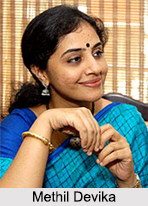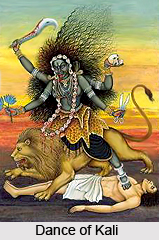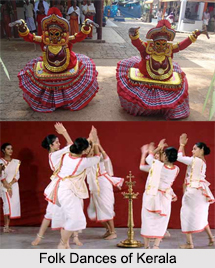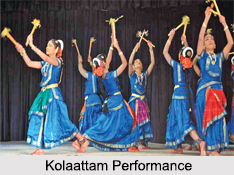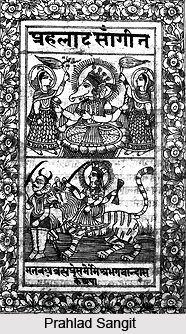 The earliest illustrations of lithographed Sangits of Nautanki are preserved in the British Library are Prahlad Sangit (1866) and Gopichand Bharatan (1867), both written by one Lakshman Singh (also known as Lakshman Das) and published from Delhi. Each of these was reprinted many times, indicating their great popularity; sixteen editions of Prahlad and twenty-seven of Gopichand were published between 1866 and 1883. Two editions of Prahlad and three of Gopichand were written in Persian characters, that is to say, in Urdu language. The fact that multiple copies exist almost from the start of British collecting suggests an already established tradition of Hindi and Urdu folk drama.
The earliest illustrations of lithographed Sangits of Nautanki are preserved in the British Library are Prahlad Sangit (1866) and Gopichand Bharatan (1867), both written by one Lakshman Singh (also known as Lakshman Das) and published from Delhi. Each of these was reprinted many times, indicating their great popularity; sixteen editions of Prahlad and twenty-seven of Gopichand were published between 1866 and 1883. Two editions of Prahlad and three of Gopichand were written in Persian characters, that is to say, in Urdu language. The fact that multiple copies exist almost from the start of British collecting suggests an already established tradition of Hindi and Urdu folk drama.
The widespread availability of the Sangit of Gopichand, who published a fragment of the text in the journal of the Asiatic Society of Bengal in 1885, has made it exceedingly popular. The Gopichand and Harishchandra plays, with their example of abdication of kingly duties for a renunciant`s life, involve morality tales, inculcating otherworldliness and pursuit of spiritual perfection. Other popular Sangits, too, encouraged the faithful to renounce power and follow the example of the saints; the titles Puranmal (or Puranmal, Puran Bhagat) and Dhuruji both refer to spiritual exemplars admired in the late nineteenth century.
The theme of kingly asceticism, popular for millennia in the subcontinent, may have gained prevalence in the disturbed political conditions of eighteenth and nineteenth century in North India. Loss of power and title was part of everyday reality for the nobility, while the people experienced a dwindling of confidence in the moral authority traditionally expected of kings. The age demanded a model of virtue for future rulers and consolation for privilege usurped.
In counterpoint to these four dramas of dispossession, the fantasy world of princes and princesses and of fairies and demons played on the nostalgia for bygone days that also preoccupied the late nineteenth century. The Indarsabha of Amanat was the prototype, a play that dominated the Urdu theatre for over seventy years. Its theme of love between a fairy and a prince was a legacy of the Persian Dastan and had parallels in Indian folklore, as evidenced by the story of the fairylike Princess Nautanki who weighed only thirty-six grams. The formula of combining ribald love scenes (preferably between celestial women and mortal men), titillating cross-dressing, and bold melodrama featured in a number of popular romances of this period: Rup Basant, Saudagar Vo Syahposh, and Benazir Badr-E-Munir.
Between 1866 and 1896, thirty-two titles appeared as lithographed Sangits in the London collections. Half of them treat religious themes (seven legends of saints, nine stories from Ram and Krishna Mas); more than a third are romances (nine Hindu or regional, three Islamic), and only a handful are heroic and contemporary stories (two martial chronicles, two modern stones). The most popular as measured by reprinting were the legends of saints (Gopichand, Puranmal, Raja Harishchandra, Dhuruji, Prahlad) followed by the romances Rup basant and Saudagar vo syahposh. The plays were most frequently published from Delhi by Mishra Bhagvan Das of Brahman Press and by Munshi Naval Kishor; from Meerut by Pandit Hardev Sahay of Jnan Sagar Press and
It is difficult to ascertain much about the authors at this time. Rarely does the author`s name appear on the title page. Instead the poet usually mentions himself in an invocatory verse, where he speaks as a suppliant requesting blessing from the deity.
The manuscripts are hand copied by scribes with highly ornamented covers featuring illustrations of central scenes and characters. Often the pages of text are also illustrated in a manner similar to folk styles of painting of the time. The widespread use of visual-images together with printed text suggests a midway point on the continuum between simple images and learned books, comparable to the chapbooks of sixteenth-and seventeenth-century France. Such materials, suggest the multiple uses to which a text could be put. For the literate classes the text constituted reading matter, while for those unable to read the pictures outlined the narrative, served as a basis for oral (including memorized) recitation, and rendered the written word a familiar part of everyday life. The appearance of these texts is remarkably similar from one publisher to another, the handwriting of the scribe being the most individualizing feature. The plays are most frequently thirty-two pages in length, and the Urdu versions of some are published separately or back to back with the Devanagari. The title is boldly displayed in Devanagari and often Urdu as well, with the publisher`s details appearing at the bottom of the page. In the early manuscripts, the poetic lines are penned running on continuously with no indentation. Only stanza numbers and full stops are inserted to show where lines end. In later texts, lines and stanzas are separated and centred on the page, and the characters` speeches are prefaced by indications such as "reply of the queen to the king". The names of the meters are specified in full or abbreviated form in all the manuscripts of the period.
